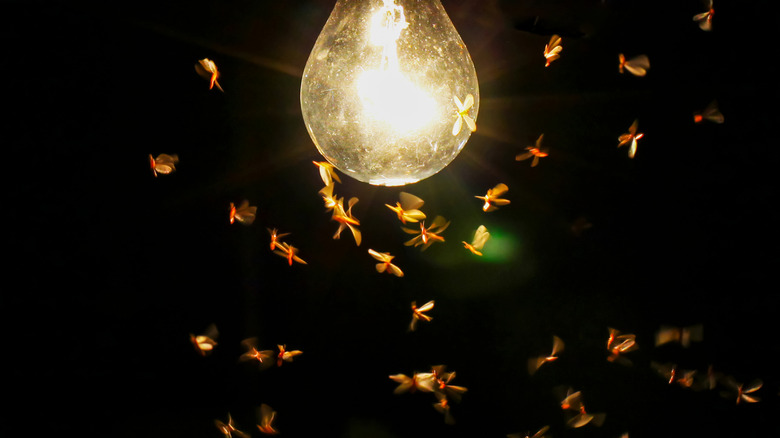The Unexpected Reason Bugs Flock To Your Porch Light
The observation that bugs are attracted to light goes back centuries — probably even millennia. Shakespeare referenced the strange phenomenon in 1596 when, in "The Merchant of Venice," he wrote, "Thus hath the candle singed the moth; O, these deliberate fools." But the reason why moths flock to artificial lights has always been a mystery. One oft-repeated explanation is that the bugs are drawn to light sources because they mistake them for the light of the moon. However, such reasoning would predict nocturnal creatures to fly into the upper atmosphere in an ill-fated journey towards the moon. And yet, they don't.
A 2024 Nature Communications study from Imperial College London finally has a credible answer, and it's more bizarre than expected. The researchers discovered that insects aren't drawn directly to the light at all. "Instead," writes the team, "insects turn their dorsum toward the light, generating flight bouts perpendicular to the source." This explains why so many flying bugs circle the spherical light of a porch light bulb rather than fly directly into it: They don't want to fly towards the moon — they want to fly beneath it.
Insects turn their dorsa, or midsections, perpendicular to a light source in order to maintain their altitude. In other words, flying perpendicular to the light of the sun or the light of the moon helps them fly upright and parallel to the ground. However, when you introduce a single point of artificial light, like a lightbulb on a porch, insects must continuously reorient themselves as they approach it from different angles. This explains why both nocturnal flying insects and diurnal insects fall prey to the phenomenon. The behavior is more or less a glitch in the bugs' nervous systems, which the researchers describe as being "entrapped by the confusion of a celestial compass."
How researchers unlocked the moth to the flame mystery
The 2024 study was far from the first to question the "light entrapment phenomenon." Until then, several other hypotheses were ruled out, while others remained untested. These include the "escape mechanism" theory, which suggests flying insects are instinctually drawn to light gaps in foliage; the "thermal radiation" theory, that the bugs are seeking a heat source; and the "night blindness" theory, that nocturnal eyesight may be blinded by the brightness of artificial lights and cause erratic flight patterns.
Finally, the technology has caught up to the theory. In 2024, Samuel T. Fabian and Yash Sondhi of the Imperial College London designed a study to generate 3D flight path models of insects as they flew around artificial lights. The study was split into two parts. In the laboratory, the team used motion capture technology to record insects in controlled settings. In the field, the team recorded wild insects as they flew around artificial lights using multiple cameras, allowing for "stereo-videography" which was then stitched together to generate a 3D map of the subjects' pathways. Finally, the team compared the recorded flight maps to computer simulations to determine that the flying insects were indeed orienting themselves perpendicularly to light sources.
The study does more than just solve an age-old curiosity. Insect populations across the globe are collapsing in a trend that's been deemed the "insect apocalypse," and it's likely that artificial lights have a part to play in the phenomenon. Scientists suspect light pollution is partially why butterflies are disappearing and why fireflies are in decline. By illuminating our understanding of how the natural world is affected by our artificial influence upon it, the London scientists believe their findings can help inform decisions towards conserving the lives of our fellow insect earthlings.

